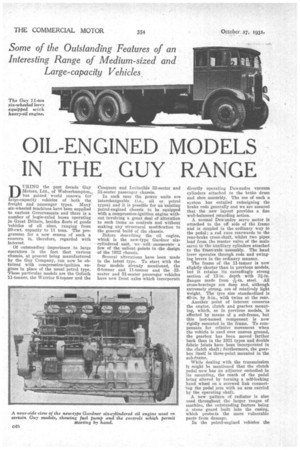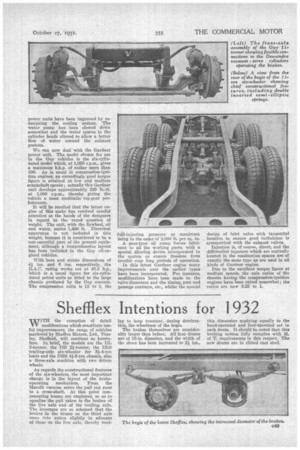OIL-ENGINED MODELS IN THE GUY RANGE
Page 98

Page 99

If you've noticed an error in this article please click here to report it so we can fix it.
Some of the Outstanding Features of an Interesting Range of Medium-sized and Large-capacity Vehicles
DT.TRINCthe past decade Guy Motors, Ltd., of Wolverhampton,. has gained world renown for large-capacity vehicles of both the freight and passenger types. Many six-wheeled machiues have been supplied to various Governments and there is a number of bogie-axlecl buses operating in. Great Britain, besides fleets of goods Vehicles of all sizes, ranging from :30-cwt. capacity to 11 tons. The programme for a new season of such a concern is, therefore, regarded with Interest,
Of outstanding -importance to large operators is the fact that various chassis, at present being manufactured by the Guy Company, can now be obtained with compression-ignition engines in place of the usual petrol type. These particular models are the Goliath 11-tonner, the Warrior 6-tofiner and the
Conquest and Invincible. 32-seater and 51-seater passenger chassis.
In each case the power units are interchangeable (i.e., oil or petrol types) and it is possible for an 'existing petrol-eng-ined chassis to be equipped with a compression-ignition engine without involving a great deal of alteration to such items as controls and without making any structural modification to the general huild of the chassis.
Before describing the oil engine, which is the new-type Gardner sixcylindered unit, we will enumerate a few of the salient points in-the design of the 1932 chassis.
Several alterations have been made in the latest type. To start with the four models already mentioned, the CI-tont-ler and 11-tonner and the 32seater and 51-seater passenger vehicles have new front axles which incorporate directly operating Dewandre vacuum cylinders attached to the brake drum and shoe assembly. The use of such a system has entailed redesigning the brake rods generally and we are assured that the new layout provides a fine well-balanced retarding action.
A normal Dewandre servo motor is attached to the off side of the frame and is coupled in the ordinary way to the pedal; a rod runs rearwards to the rear-brake cross-shaft, whilst two pipes lead from the master valve of the main servo to the auxiliary cylinders attached to the front-axle assembly. The hand lever operates through rods and swinging levers in the ordinary manner.
The frame of the 11-tonner is now slightly shorter than in previous models, but it retains its exceedingly strong section of 12-in, depth with 3.1-in.
flanges made from steel. All cross-bracing,s are deep and, although extremely strong, are of relatively light weight. The tyre size standardized is 40-in. by S-in., with twins at the rear.
Another point of interest concerns the engine, clutch and gearbox mounting, which, as in previous models, is effected by means of a sub-frame, but this last-named component is now rigidly mounted in the frame. To compensate for relative movement when the vehicle is used over uneven ground, the gearbox has been moved farther back than in the 1931 types and double fabric joints have been incorporated in the clutch shaft; furthermore, the gearbox itself is three-point mounted in the sub-f rame.
While dealing with the transmission it might be mentioned that the clutch pedal now has an adjuster embodied in its mounting, the reach of the pedal being altered by turning a self-locking band wheel on a screwed link connecting the pedal arm with air arm carried by the operating shaft.
A new pattern of radiator is also used throughout the larger ranges of machine, the outstanding feature being a stone guard built into the casing, which protects the more vulnerable parts from damage.
In the petrol-engined vehicles the
power units have been improved by redesigning the cooling system. The water pump has been slowed down somewhat and the water spaces in the cylinder heads altered to allow a bettor flow of water around the exhaust pockets.
We can now deal with the Gardner power unit The model chosen for use in the Guy vehicles is the six-cylindered model which, at 1,650 r.p.m., gives a maximum b.h.p. of rather more than 100. As is usual in compression-ignition engines, an exceedingly good torque figure is attained at low and medium crankshaft speeds ; actually this Gardner unit develops approximately 350 /b..-ft. at 1,000 r.p.m., thereby giving the vehicle a most creditable top-gear performance.
It will be recalled that the latest engine of this make has received careful attention at the hands of the designers in regard to the vexed question of weight. The unit, with the flywheel, oil and water, scales 1,480 lb. Electrical apparatus is not included in this weight, because it is considered to be a non-essential part of the general equipment, although a comprehensive layout has been included in the Guy oil-engined vehicles.
With bore and stroke dimensions of 41ins. and 0 ins, respectively, the R.A.C. rating works out at 43.5 h.p., -Which is a usual fig-are for six-cylindered petrol units as fitted to the large chassis produced by the Guy concern. The compression ratio is 13 to 1, the
fuel-injection pressure at maximum being in the order of 2,000 lb. per sq. in.
A gear-type oil pump forces lubricant to all the working parts, with a special filtering device incorporated in the system to ensure freedom from trouble over long periods of operation.
In this latest Gardner engine many improvements over the earlier types have been incorporated. For instance, modifications have been made to the valve diameters and the timing, port and passage contours, etc., whilst the special
design of inlet valve with tangential location to ensure good turbulence is symmetrical with the exhaust valves. Injection is, of course, direct, and the differenfial injectors which are centrally located in the combustion spaces are of exactly the same type as are used in all kinds of Gardner engine.
Due to the excellent torque figure at medium speeds, the axle ratios of the chassis having the compression-ignition engines have been raised somewhat ; the ratios are now 8.25 to 1.




































































































































































